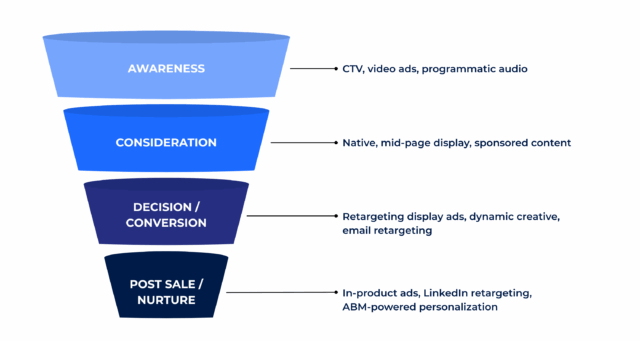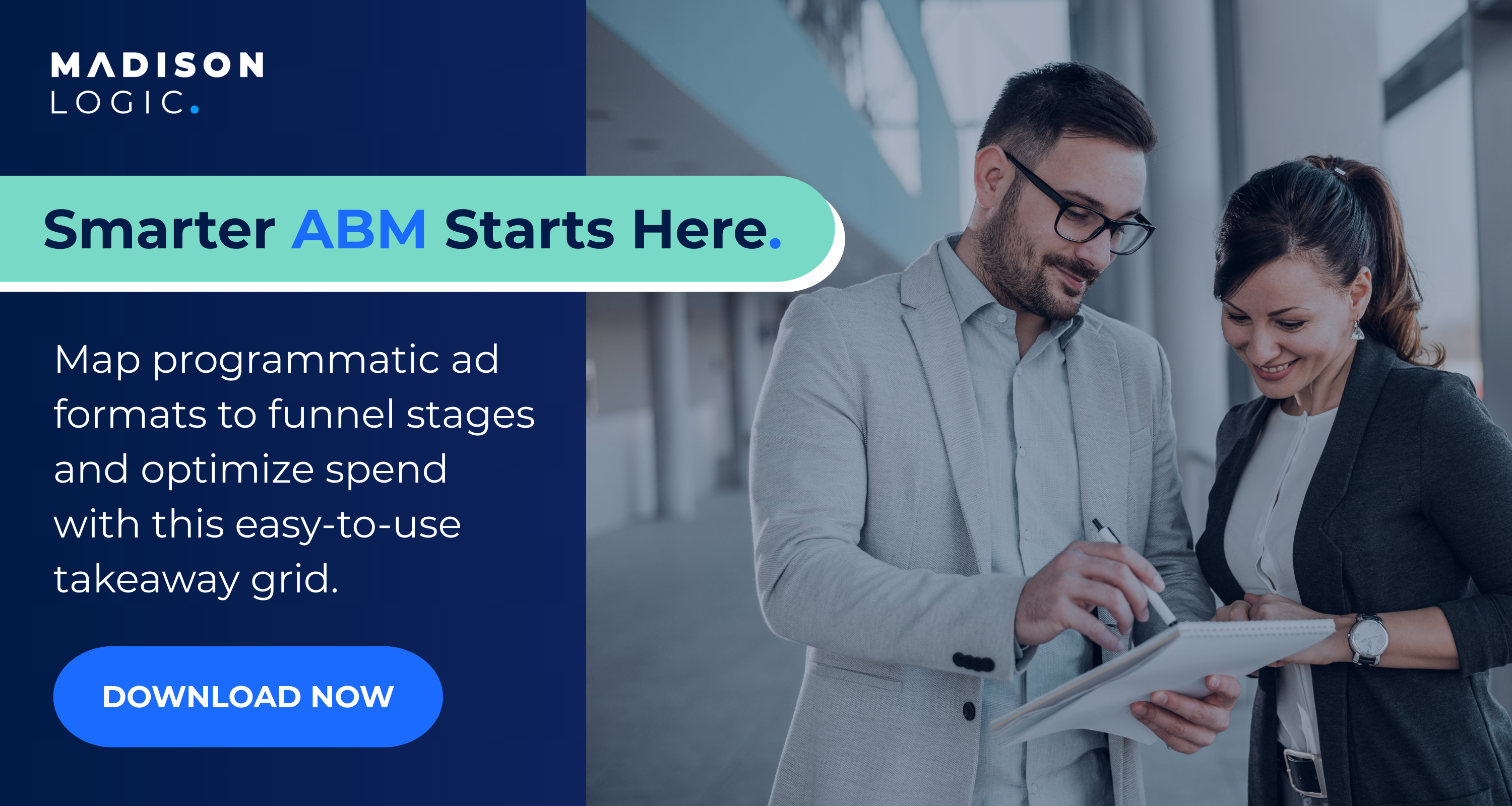Programmatic advertising is transforming digital marketing, rapidly becoming the dominant force behind ad spend across channels. With programmatic expected to power 75% of all digital ad spend soon, it’s clear that the shift toward automated, insight-led media buying is no longer optional—it’s essential.
Yet, unlocking its full potential isn’t just about automation—it’s about precision. With a growing array of format options spanning across display advertising, native advertising, audio advertising, video, social media (especially B2B’s largest social network LinkedIn), and connected TV (CTV), knowing which programmatic ad type to use—and when—is critical for driving engagement across the buyer’s journey.
This guide cuts through the complexity, helping you make smarter choices based on real-world challenges like size selection, file specs, and placement context. We’ll explore each format with technical clarity, tie them back to account-based strategies, and show how to match format to funnel stage for maximum impact.
The Confusion: Format Overload in Programmatic Advertising
The biggest challenge isn’t technical—it’s strategic overload. With a growing list of ad formats, placement options, inventory sources, and creative requirements, many B2B marketers are overwhelmed before the campaign even begins.
This confusion stems from more than just the number of choices—it’s about how to match those choices to specific goals, buyer stages, and performance expectations. The risk? Wasted spend, missed signals, and underwhelming results.
Let’s break down the most common barriers:
- Overchoice Paralysis: With display, native, video, audio, CTV, and emerging formats like in-game and digital out-of-home (DOOH) advertisements, marketers often find themselves asking, “Which format is right for this target audience and objective?” The sheer number of options can lead to analysis paralysis—and worse, inaction or missteps.
- Brand Safety & Fraud Risk: CMOs are increasingly cautious about where and how their digital ads show up. Open exchanges and low-quality inventory can expose brands to unsafe or irrelevant placements, while bots and click fraud continue to siphon budgets away from real engagement.
- Creative Fragmentation: The demand for format-specific ad creatives strains internal and external resources. A single campaign might require multiple versions of display ads, video cuts, or interactive assets—each optimized for a unique context or device.
- Format Mismatch: Using the wrong format for the wrong job is a silent campaign killer. Display might lack impact for brand storytelling, while native placements may not have the immediacy needed for a retargeting push.
- Attribution Fog: With multiple formats running across siloed platforms and channels, measuring true performance is tough. Walled gardens like Google Ads, YouTube, and LinkedIn that don’t allow third-party data into their systems and inconsistent data sharing make full-funnel attribution a constant battle.
The Solution: Start with Strategy to Navigate the Noise
When faced with dozens of programmatic ad formats and placements, it’s easy to get distracted by shiny new options or default to what’s familiar. While you may have solid messaging, you need to ensure that you deliver it in the right medium to drive meaningful results. You must move beyond reactive planning and anchor format decisions in strategy. That means flipping the conversation from “Which ad type should we use?” to “What are we trying to achieve, and how do these ad formats support that goal?”
Your messaging and content needs to align with your campaign goals, the buyers’ needs, and the buyers’ stage. As part of an ABM strategy, where you speak to multiple stakeholders in a buying group who move through the funnel at different speeds and have their individual and collective concerns, you need your ads to stand out. Here’s how to cut through the clutter:
- Clarify the Objective: Is your campaign focused on brand awareness, education, engagement, conversion, or retention? Format selection should begin with your end goal, not the latest trend.
- Align with the Buyer Journey: Next, map each format to the right stage of the journey. Below is an example, as successful ABM strategies consider an always-on approach to ensure stakeholders receive messaging and content exactly when they need it:

- Select Based on Fit and Function: Finally, make sure the goal and audience align with the format—not the other way around. For example, if your goal is to re-engage high-fit accounts showing late-stage intent, display retargeting or native ads might outperform broader awareness buys on video or audio.
The Formats: What to Use When (and Why)
The power of programmatic lies in precision—but only if you match the format to the job. Here’s a breakdown of key programmatic ad formats, how they function, and where they can fit in the B2B buyer journey.
Display Ads
- What It Is: Standard or rich media banner ads placed across websites and apps
- Best For: Awareness, reengagement, and light nurture
- Why Use It:
- Scalable reach across the open web and private marketplaces
- Great for account-based targeting and frequency building
- Retarget visitors or serve dynamic creative by persona or industry
- Key Specs: Flexible aspect ratios, LEAN principles (lightweight, non-disruptive) (aka Light, Encrypted, AdChoices supported, and Non-invasive)
- Sizes to Include: 300 x 250, 728 x 90, 160 x 600, 970 x 250, 320 x 50
- Challenges:
- Banner fatigue—use LEAN units to improve user experience
- Brand safety and fraud risks, especially on open exchanges—use pre-bid filters and trusted inventory sources
- Needs strong creative and frequency capping
Native Ads
- What It Is: Sponsored content that blends into the design of the surrounding page (like articles and recommended reads)
- Best For: Top of funnel thought leadership and mid-funnel consideration
- Why Use It:
- High engagement and non-disruptive
- Creates implied authority with placement
- Perfect for promoting gated assets, case studies, or blog content
- Drives qualified traffic while preserving brand voice
- Key Specs: IAB Native Ad Specifications—ensure headlines, descriptions, images follow standardized templates
- Challenges:
- Requires strong editorial-style creative, alignment with publisher style, and headline testing
Video
- What It Is: Video units placed before, during, or within online content across web and mobile
- Best For: Top of funnel awareness and mid-funnel education and engagement
- Why Use It:
- Perfect for communicating product benefits in short bursts
- Can tie to thought leadership (e.g., repurposing webinars, explainers)
- Encourages longer engagement and stronger recall
- Key Specs:
- Linear formats: 6–30 sec pre/mid/post rolls; <1s duration variance
- Bitrate & resolution: 360p–4K adaptive (bitrate ~0.05–0.1 VBPP, AAC 192 kbps audio)
- Companion and nonlinear overlays supported
- Challenges:
- Must tailor video length to platform and user behavior
- Higher cost
- Compliance with VAST 4.0 and VPAID/remove interactive (per IAB Tech Lab)
Search & Social Media
- What It Is: Ads driven by user intent based on buyer signals, behavior, and engagement served on platforms like Google, LinkedIn, and Meta via digital signal processing (DSP) data or orchestration
- Best For: Mid-to-late funnel; supplementing owned and paid programs
- Why Use It:
- Taps into existing buyer intent
- Helps reinforce messaging across multiple touchpoints
- Supports precision targeting on high-intent platforms
- Key Specs: Align with IAB’s flexible and lean ad principles (e.g., LEAN, dynamic creative) (per IAB Tech Lab).
- Challenges:
- Requires cross-platform alignment and budget coordination
Audio Ads
- What It Is: Ads inserted into streaming audio platforms (e.g., podcasts, music apps)
- Best For: Brand awareness building and mid-funnel engagement with key decision-makers
- Why Use It:
- Reaches busy decision-makers on the move—especially executive-level engagement
- Great for thought leadership and memorable messaging
- Can complement CTV and display with voice-based reinforcement
- Key Specs: ~15–30 sec with companion banners per IAB’s podcast/audio best practices (per IAB Tech Lab)
- Challenges:
- Limited direct-response attribution
- Longer-term commitment due to needing longer campaign times to see performance impact, which makes it better suited for branding
- Newer channel, so it’s less familiar to develop ads
Connected TV
- What It Is: Video ads streamed on internet-connected televisions (e.g., Hulu, Roku, YouTube TV) or other devices
- Best For: High-impact awareness campaigns and middle funnel engagement
- Why Use It:
- High viewability and completion rates
- Great for brand storytelling and building emotional resonance
- Targets specific industries or job functional areas with precision
- Key Specs:
- Supports server-side ad insertion (SSAI), macros, measurement, and brand safety per the CTV Programmatic Guide from IAB Tech Lab.
- Non-interactive 15–30 sec linear spots.
- Challenges:
- High cost per thousand (CPM)
- Limited direct-response attribution
- Less effective without supporting touchpoints elsewhere
Practical Takeaways for Stronger Multi-Channel Programmatic Campaign Performance
Navigating the maze of programmatic formats is less about guessing what works and more about building a strategy around data, intent, and buyer behavior. The right ad format, deployed at the right time, can accelerate account engagement and drive real pipeline impact. But misalignment—whether it’s between content and context, or creative and channel—can waste budget and stall momentum. These practical tips help you get the most from every impression.
Don’t Default—Let Intent and Tier Guide Format Choice
Refer to your target account tiers and intent signals to prioritize which formats get premium placement. High-intent, high-tier accounts may warrant immersive video or native content, while mid-tier accounts might respond well to retargeting display or carousel ads.
Walk Before You Run
Before pressing “launch,” map your ad format to the buyer stage, account priority, and available creative assets. Starting with this strategic foundation helps avoid misfires (like running bottom-funnel formats for top-funnel goals) and ensures your spend supports the full journey.
Spec Compliance Isn’t Optional
Following IAB specifications might not feel glamorous, but it keeps production timelines on track and ensures your ads are eligible for the widest range of placements. Bonus: fewer headaches for your creative team.
Modular Creative Wins the Long Game
Think building blocks, not one-offs. Developing video snippets, headline variations, and interchangeable visuals allows you to quickly adapt and optimize creative for different formats without reinventing the wheel each time.
Multi-Channel Is Mandatory
No single format can do it all. Buying groups are bigger and use more channels, so success depends on connecting with them wherever they are. Pair video with native to drive top- and mid-funnel engagement, use display for retargeting, and anchor everything in real-time intent data to personalize outreach. When channels work in concert, the result is stronger brand presence and smoother buyer progression.
Closing the Programmatic Loop: From Format Chaos to Funnel Clarity
Programmatic advertising isn’t just about automation—it’s about orchestration. The most effective programmatic campaigns are those that treat formats not as standalone tactics, but as pieces of a connected, data-informed buyer experience. By aligning ad format with funnel stage, maintaining creative flexibility, and prioritizing intent-led targeting, you can drive performance across every stage of the journey. Choose with purpose, execute with precision, and watch your programmatic impact grow.
With solutions such as ABM Audio Advertising, ABM Connected TV, and ABM Display Advertising, Madison Logic empowers marketers to reach decision-makers across channels and formats with precision, speed, and intent. Whether it’s awareness-stage video, mid-funnel native, or conversion-driving display, our integrated platform ensures your message is seen, heard, and acted on—by the right accounts, at the right time.
Let’s talk about how Madison Logic can accelerate your full-funnel ABM performance through programmatic advertising. Request a demo to learn more.



















